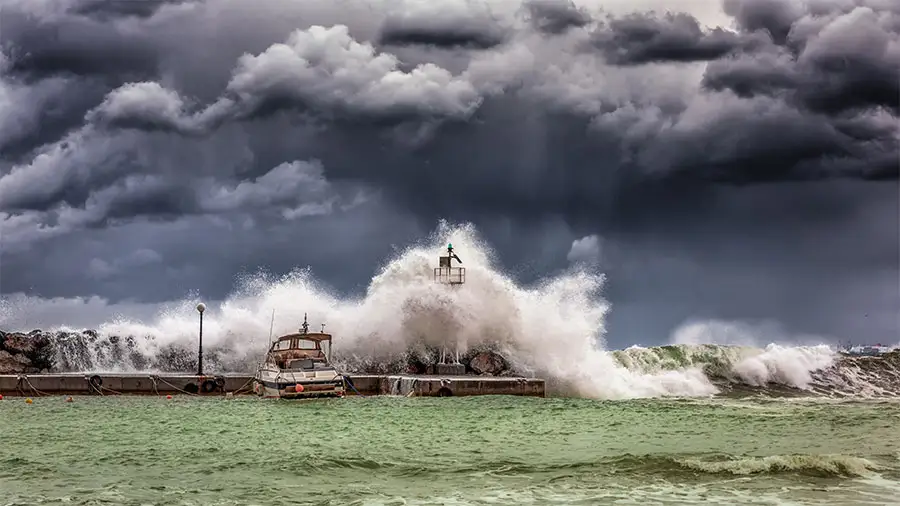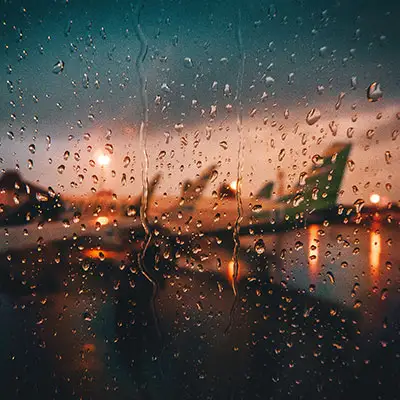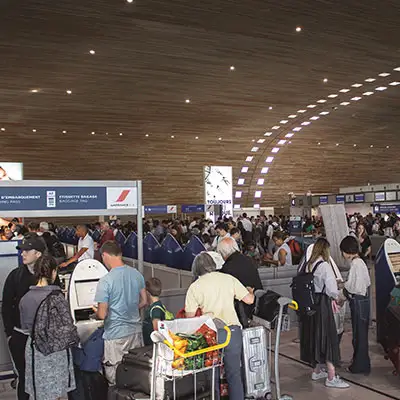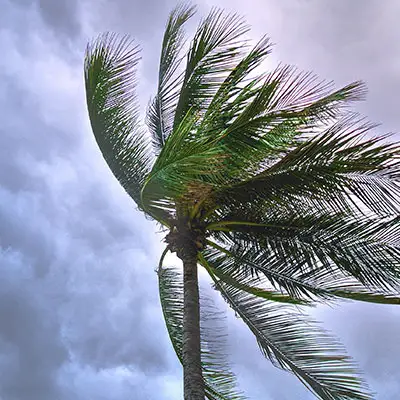What You Need to Know About Hurricanes and Travel Insurance
Angela Borden | Aug 4, 2023

If you plan to travel anytime from June 1 through Nov. 30, you should be aware it is hurricane season. We highly recommend you consider purchasing travel insurance to cover your travels during this time.
Once again, meteorologists are predicting an active hurricane season this year, meaning there is potential for a higher-than-average number of storms. The peak months for hurricanes include August, September, and October.
Protecting Yourself During Hurricane Season

One of the best ways to protect yourself during hurricane season is to be prepared. Start by learning the important things you should know about hurricanes, including high-risk locations where you’re most likely to experience one and what to do if a hurricane threatens or interrupts your travel plans.
You can also be prepared by purchasing travel insurance. Travel insurance includes benefits and coverage for reasons specifically related to weather events, including hurricanes, that can adversely affect travel.
If you have questions about how travel insurance can help you with weather emergencies, you’ve come to the right place.
There are two types of plans that include different benefits that can apply for weather emergencies such as a hurricane. These benefits can help protect you and your trip from the uncertainties of hurricane season. It is important to note that benefits and covered reasons vary by plan, so check your plan document or call us if you’re not certain about your coverage.
Trip Protection Plan Benefits
There are many reasons a hurricane could cause you to cancel, abruptly interrupt, or delay a trip, so it’s important to know the various ways travel insurance can offer protection if you choose to go on a trip during hurricane season.
For a plan such as Seven Corners Trip Protection, there are several benefits related to hurricanes. Here’s what you’ll find in the first section of this article:
- Trip Cancellation coverage
- Trip Interruption coverage
- Optional Cancel for Any Reason (CFAR) coverage
- Optional Interruption for Any Reason (IFAR) coverage
- Trip Delay coverage
- Missed Tour or Cruise Connection coverage
Trip Cancellation coverage
Seven Corners Trip Protection has a specific hurricane-related trip cancellation trigger for coverage: Your Scheduled Trip Departure City or Scheduled Destination is under a hurricane warning or hurricane watch as issued by the NOAA Hurricane Center within 24 hours of Your Scheduled Departure Date. Cancellation of Your Trip must occur more than 14 days following Your Effective Date of coverage for Trip Cancellation.
If you must cancel your trip, benefits can be paid to reimburse you for your unused and nonrefundable prepaid trip payments. In addition, the Trip Protection Choice plan includes a Frequent Traveler Reward Benefit, which covers up to $500 for airline fees to re-bank frequent flyer miles due to a covered reason.
Trip Interruption coverage
Seven Corners Trip Protection plans also have a specific hurricane-related trip interruption trigger for coverage: Your Scheduled Destination is under a hurricane warning or hurricane watch, as issued by the NOAA Hurricane Center, after Your Scheduled Departure Date.
If you must interrupt your trip, Trip Protection Choice benefits reimburse up to 150% of the insured trip cost, and Trip Protection Basic benefits reimburse up to 100% of the insured trip cost. The coverage is triggered when you interrupt your trip for a covered reason listed in the plan document.
This amount is paid to reimburse you for your unused and nonrefundable trip payments for your travel arrangements plus additional transportation costs for you to:
- Join your trip if you must depart after your scheduled departure date or travel via alternate travel arrangements; or
- Rejoin your trip from the point where you interrupted it to the next scheduled destination; or
- Transport you to your originally scheduled return destination
COVERED REASONS FOR CANCELLING OR INTERRUPTING A TRIP DUE TO WEATHER

There are three covered reasons in Seven Corners Trip Protection plans that provide coverage if you must cancel or interrupt your trip due to weather. They include:
- Inclement weather, including a hurricane, causes a common carrier to end its services for at least 48 consecutive hours. A common carrier may include an airline or cruise line.
- Your primary residence or scheduled destination accommodations become uninhabitable and remain uninhabitable during your trip or are inaccessible by the mode of transportation shown on your itinerary within 30 days of your departure date due to a natural disaster. In the case of a hurricane, coverage will only apply if you purchased insurance prior to a tropical storm being upgraded to a hurricane.
- An evacuation mandate is issued by local authorities at the scheduled trip departure or scheduled destination due to a natural disaster, including a hurricane, which prevents traveling to/arriving at your scheduled trip departure city or scheduled destination. For Trip Cancellations, this applies only if you bought the plan during the Time Sensitive Period, meaning the plan must be purchased within 20 days of the date your initial payment or deposit for your trip is received and within 15 days of payment for subsequent travel arrangements you add to your trip.
Cancel for Any Reason coverage
If you would like the option to cancel your trip for any reason you wish, consider adding the optional Cancel for Any Reason (CFAR) benefit.*
CFAR will increase the price of your plan by approximately 40% and will reimburse you for up to 75% of your nonrefundable prepaid trip costs if you do the following (additional terms apply beyond those discussed below):
- Cancel your trip 2 days or more before your trip start date (scheduled departure date) and
- Buy a plan with CFAR coverage within 20 days of the date your initial trip deposit is received (the first day you make a payment for your trip) and
- You must also insure the cost of subsequent travel arrangements within 15 days of payment or deposit for them. An example of a subsequent travel arrangement could be adding an excursion to your cruise after you had previously paid for the cruise.
Interruption for Any Reason coverage
If you would like the option to interrupt your trip for any reason you wish, consider adding the optional Interruption for Any Reason (IFAR) benefit*.
IFAR will increase the price of your plan by 10% or less and could provide reimbursement for up to 75% of nonrefundable unused trip costs should you decide to interrupt your trip and return home early due to concern about hurricanes, even if a hurricane warning or watch has not been issued by NOAA.
Trip Delay coverage
This benefit protects you for the following types of delay:
- Any delay of a common carrier, which includes delays due to a hurricane.
- A mandatory evacuation order at your scheduled departure city or scheduled destination or return destination is issued which prevents you from traveling to/arriving at your scheduled departure city or scheduled destination or return destination.
The trip delay benefit can pay for accommodations, meals, and local transportation expenses you incur if you’re delayed six hours** or more en route to or from your trip as well as during your trip.
There are other coverage triggers as well for this benefit, so check the plan document for more details.
Missed Tour or Cruise Connection coverage
This benefit can pay if you miss your cruise or tour departure because your arrival at your destination is delayed for three or more hours due to covered reasons. These covered reasons include some related to weather, such as any delay of a common carrier, including a delay caused by inclement weather.
This benefit can pay for:
- Additional transportation costs to join your cruise or tour.
- Accommodations, meals, and local transportation.
Are you interested in buying trip insurance? Get a quote! →
Travel Medical Benefits

Seven Corners Travel Medical plans offer natural disaster coverage when traveling internationally. For this type of plan, a natural disaster includes hurricanes, tornadoes, typhoons, tsunamis, cyclones, floods, and more. See the plan document for the full definition of natural disaster.
The natural disaster benefits included we’ll discuss in this section include:
- Daily benefits for accommodations
- Trip interruption
- Evacuation and repatriation
Natural disaster daily benefit for accommodations
Our plans reimburse you a daily rate up to five days for replacement accommodations if you cannot stay at your planned, paid destination accommodations because of an evacuation due to a natural disaster. The reimbursement rate per day depends on which plan you select.
Trip interruption
If you cannot continue your trip due to serious damage to your principal residence caused by a hurricane or other natural disaster, Seven Corners travel medical insurance plans will reimburse you for the cost of economy travel, less any credit from an unused return travel ticket home.
Natural disaster evacuation and repatriation
If you require a natural disaster evacuation from a location outside of the United States, the plan can arrange and pay to evacuate you from a safe departure point to the nearest safe location. We can also arrange and pay for up to five days of accommodations if you are delayed at the safe location and arrange to pay for one-way airfare to return you to your home country following evacuation.
Coverage amounts vary by plan. The trip interruption and natural disaster evacuation benefits must be arranged by Seven Corners Assist.
Are you interested in buying a travel medical insurance plan? Get a quote! →
Timely Purchase
It is important to read your plan document and buy your travel insurance before the natural disaster occurs.
Since hurricanes are erratic and hard to predict, it's important to prepare ahead of time, especially if you are traveling during hurricane season, especially in high-risk locations.
What to Do If You Have Questions
If you have questions about what type of plan to choose for your next trip, contact our licensed travel insurance agents today.
Email sales@sevencorners.com or call the numbers below.
Toll free 1-800-335-0611
Worldwide +1-317-575-2652
Collect +1-317-818-2809
Travel Like a Pro with The Wayfinder
Did you enjoy this blog? Get more articles like it before anyone else when you subscribe to our monthly newsletter, The Wayfinder.
*CFAR is not available in all states. When you complete the quick quote in our purchase process, it will be presented to you as an option if it is available. This Cancel for Any Reason Benefit does not cover Travel Arrangements not provided by the Travel Supplier or the failure of the Travel Supplier to provide the bargained-for Travel Arrangements due to cessation of operations for any reason.
IFAR is not available in all states. When you complete the quick quote in our purchase process, it will be presented to you as an option if it is available. This benefit does not cover penalties associated with Travel Arrangements not provided by the Travel Supplier for this Trip and failure of the Travel Supplier to provide the agreed upon arrangements for Your Trip for any reason.
**This time limit varies by state and plan. Review your plan document for details.
The following disclaimer applies to Seven Corners Trip Protection plans only.
Important Information from the United States Fire Insurance Company
AH-4137
Search Posts
Receive our monthly inspiration and travel tips from the travel insurance experts.
Sign me upThis website and various social media updates provided by Seven Corners contain content, information, articles, videos, and links to websites created by third parties. Seven Corners, its owners, and its employees neither endorse nor are responsible for the accuracy, timeliness, or reliability of any third-party information, statements, opinions, or advice and are not liable for any loss, harm, or damage caused by your reliance upon them. Use of such information or the linked websites is entirely at your risk. Concerns regarding this third-party content should be directed to the third party. Seek professional advice, as appropriate, regarding your use of such information and websites.
Because the information on this website and in Seven Corners’ blogs and other social media is written and compiled using knowledge and information available at a certain point in time, it may become outdated. For that reason, information, events, legal requirements, and product changes (including benefits, limitations, exclusions, and services) may not be up-to-date, complete, or accurate at the point in time it is being read. Again, use of such information is at your risk.
